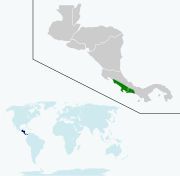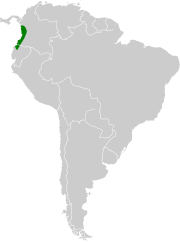| Polyerata | |
|---|---|

| |
| Blue-chested hummingbird, (Polyerata amabilis) | |
| Scientific classification | |
| Domain: | Eukaryota |
| Kingdom: | Animalia |
| Phylum: | Chordata |
| Class: | Aves |
| Clade: | Strisores |
| Order: | Apodiformes |
| Family: | Trochilidae |
| Tribe: | Trochilini |
| Genus: | Polyerata Heine, 1863 |
| Type species | |
| Trochilus amabilis (blue-chested hummingbird) Gould, 1853 | |
| Species | |
|
See text | |
Polyerata is a genus of hummingbirds.
Species
The genus contains three species:
| Common name | Scientific name and subspecies | Range | Size and ecology | IUCN status and estimated population |
|---|---|---|---|---|
| Blue-chested hummingbird | Polyerata amabilis (Gould, 1853) |
Colombia, Costa Rica, Ecuador, Nicaragua, and Panama
|
Size: Habitat: Diet: |
LC
|
| Charming hummingbird | Polyerata decora Salvin, 1891 |
Costa Rica and Panama.
|
Size: Habitat: Diet: |
LC
|
| Purple-chested hummingbird | Polyerata rosenbergi Boucard, 1895 |
Colombia and Ecuador.
|
Size: Habitat: Diet: |
LC
|
These species were formerly placed in the genus Amazilia. A molecular phylogenetic study published in 2014 found that Amazilia was polyphyletic. In the revised classification to create monophyletic genera, these three species were moved to the resurrected genus Polyerata that had been introduced in 1863 by the German ornithologist Ferdinand Heine to accommodate the blue-chested hummingbird which therefore becomes the type species. The genus name is from Ancient Greek poluēratos meaning "very lovely".
References
- ^ Gill, Frank; Donsker, David; Rasmussen, Pamela, eds. (July 2020). "Hummingbirds". IOC World Bird List Version 10.2. International Ornithologists' Union. Retrieved 7 January 2020.
- McGuire, J.; Witt, C.; Remsen, J.V.; Corl, A.; Rabosky, D.; Altshuler, D.; Dudley, R. (2014). "Molecular phylogenetics and the diversification of hummingbirds". Current Biology. 24 (8): 910–916. Bibcode:2014CBio...24..910M. doi:10.1016/j.cub.2014.03.016. PMID 24704078.
- Stiles, F.G.; Remsen, J.V. Jr.; Mcguire, J.A. (2017). "The generic classification of the Trochilini (Aves: Trochilidae): reconciling taxonomy with phylogeny". Zootaxa. 4353 (3): 401–424. doi:10.11646/zootaxa.4353.3. PMID 29245495.
- Heine, Ferdinand (1863). "Trochilidica". Journal für Ornithologie (in German). 11 (3): 173–217 . doi:10.1007/BF02004901.
- Jobling, James A. (2010). The Helm Dictionary of Scientific Bird Names. London: Christopher Helm. p. 313. ISBN 978-1-4081-2501-4.
| Taxon identifiers | |
|---|---|
| Polyerata | |








